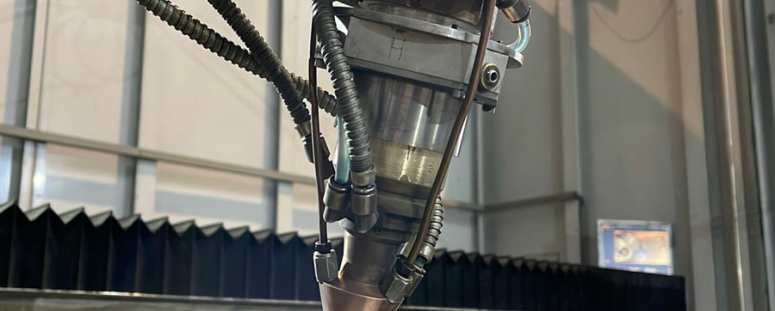How to make the surface of a turbine blade wear resistant? How to repair a torn gear wheel? How to extend the life of an oil drill? How do you add complex shapes to a part? Many possible applications for one process - laser cladding. And it sounds more complicated than it actually is.
Laser cladding has many applications. The coating of highly stressed machine parts, such as turbine blades, has already been proven in industry for years. They are subject to very high mechanical demands, such as high operating temperatures or corrosive atmospheres, combined with vibrations and tensile stresses in the radial direction. A small defect on the blade body can destroy the entire turbine. This would not only be costly, but also dangerous and would cripple the process for a long time.
The blades are made of special high-strength alloys. Additional protection against wear and corrosion is provided by a high-tech surface treatment. Laser cladding is used to apply an adherent metal coating to a complex surface such as a turbine blade. Laser cladding is also known as Laser Metal Deposition (LMD).
What are the applications for the LMD process?
There are three areas of application: coating, repair and assisted manufacturing. Surface coatings are used to protect against wear and corrosion, as is important for turbine blades. The service life of these high-quality coatings sometimes even exceeds the durability of galvanic coatings. Coating with LMD is common in many industries, such as hydroelectric power plants, thermal power plants, pumps and compressors, high-temperature components in aviation, space and navigation, power generation (electricity, oil and gas) and the chemical and pharmaceutical industry.
If multiple layers are welded together, the process can be used for repair and assisted manufacturing. This form of assisted manufacturing (AM) is suitable for less complex prototypes and one-off fabrications.
What advantages does the LMD offer?
The laser-based process is easily adaptable to different fields of application. It offers great design freedom. And since there is no need for a limiting construction chamber as with 3D printing, it is also possible to machine large parts. The process can be integrated into existing process chains at low cost. This makes it particularly attractive for small and medium-sized companies.
Lasers are a big investment with a big ROI - are they really?
Supplementing production or developing a new area of production involves high costs if you are investing in new machine installations. Used machines are an interesting alternative. At the used machine portal surplex, a high-quality, expertly tested laser cladding system can currently be purchased via auction. The offer includes a complete cell of modular design, including an oven for further processing. It includes, among other things, a high-power diode laser with cladding head and powder transport, a work area with rotating and swiveling table as well as a protective cabin, control system and curing oven. Surplex is Europe's largest industrial auction house and trades used machinery and equipment worldwide. With more than 500 online auctions per year, well over 55,000 lots change hands.
Metal-Interface takes great care to protect your privacy: when you submit a request or ask a question, your personal information is passed on to the supplier concerned or, if necessary, to one of its regional managers or distributors, who will be able to provide you with a direct response. Consult our Privacy Policy to find out more about how and why we process your data, and your rights in relation to this information. By continuing to browse our site, you accept our terms and conditions of use.
 EuroBLECH 2022 Press release
EuroBLECH 2022 Press releaseMultifunctional laser buildup welding with used machinery
Published on 06/10/22
